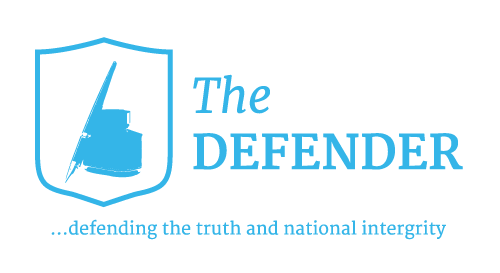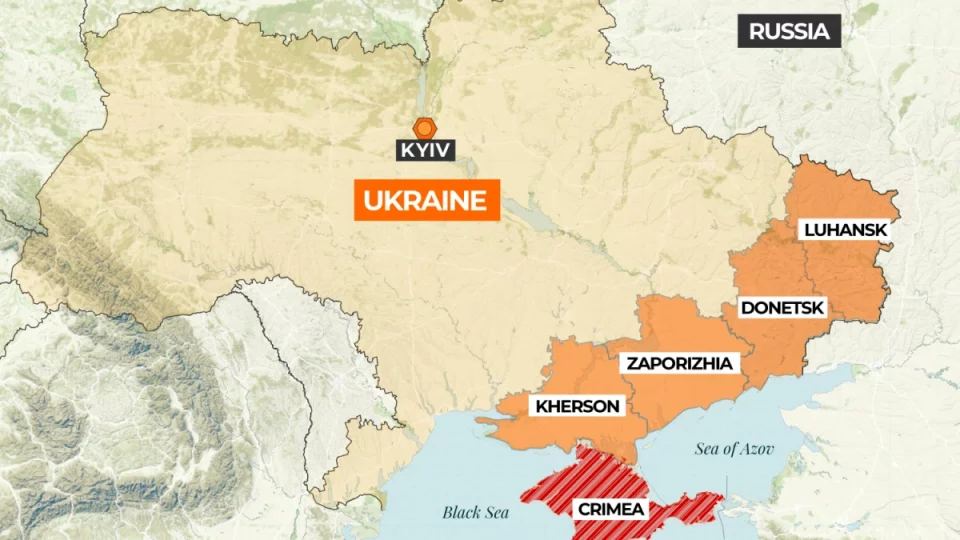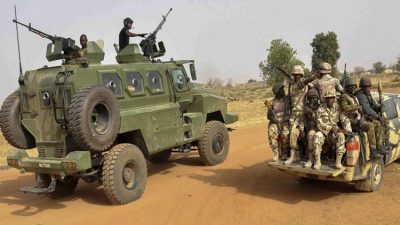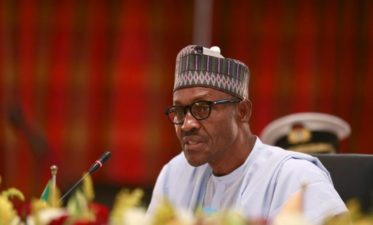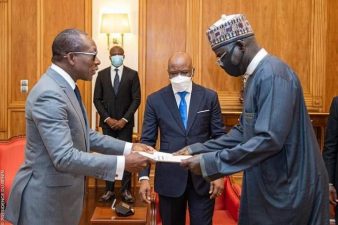(Compiled by The DEFENDER Newspaper for all you need to know about battle of Kherson, Southern Ukraine)
“No quick path to victory: Due to its location near Crimea, Russia is likely to put up a strong defense of the occupied territory of Kherson and the North Crimean Canal in particular. Observers in Ukraine and the West expect a long fight, and reckon Ukraine will not launch a frontal offensive due to insufficient forces.”
The Battle of Kherson was a military engagement between Russian and Ukrainian forces which began on 24 February 2022, as part of the southern Ukraine offensive during the 2022 Russian invasion of Ukraine.
Kherson was the first major Ukrainian city and only regional capital captured by Russian forces during the southern Ukraine offensive, according to Wikipedia in https://en.wikipedia.org/wiki/Battle_of_Kherson#:~:text=Two%20Russian%20generals%20were%20killed,%2C%20%22Russia%20is%20here%20forever
Russian offensive and capture of Kherson
February
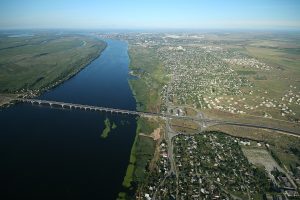
The Antonovskiy Bridge in 2006
Russian forces invaded Kherson Oblast from the south through Crimea on 24 February, with Ukrainian president Volodymyr Zelenskyy saying “Our troops are fighting fierce battles near the outskirts of Kherson, the enemy is pressing from the occupied Crimea, trying to advance towards Melitopol.” By the evening of 24 February, Russian forces reached the city of Kherson and had secured the Antonovskiy Bridge, which provides a strategic crossing over the Dnieper River and towards the important junction city of Mykolaiv.
By the early hours of 25 February, Ukrainian forces recaptured the bridge in a battle that was described as fierce and left dead soldiers and several destroyed military vehicles lying on the bridge.
The counterattack forced the Russians to push north and capture the next closest crossing of the Dnieper, the city of Nova Kakhovka. Russian troops once again seized the Antonovskiy Bridge later in the day.
On 26 February, Ihor Kolykhaiev, the mayor of Kherson, stated that Russian forces pulled back from Kherson after a Ukrainian air strike on Russian armored vehicles, allowing the city to remain under Ukrainian control. A Ukrainian official, Anton Herashchenko, later claimed that a Russian army column was defeated by Ukrainian forces near the town of Oleshky, located just south of Kherson.
Later, the Ukrainian Prosecutor General, Iryna Venediktova, claimed that Russian forces killed a journalist and an ambulance driver near Kherson. Venediktova stated that Ukrainian law enforcement had opened criminal proceedings into the shootings.
On the morning of 27 February, the Russian Ministry of Defence stated that Russian forces had encircled Kherson and, according to Ukrainian officials, captured a part of the city, including Kherson International Airport. Later in the morning, the Ukrainian Air Force allegedly conducted a successful drone strike against Russian forces in the town of Chornobaivka, just to the north of Kherson.
Ukrainian officials alleged that beginning on 27 February, Russian forces began moving civilians from nearby villages towards Kherson, attempting to use civilians as human shields.
March
In the early morning of 1 March, Ukrainian officials stated that Russian forces had launched a renewed assault on Kherson and were advancing from Kherson International Airport to the highway between Kherson and Mykolaiv. While conducting heavy shelling, Russian forces surrounded the city and reached the highway, advancing to the village of Komyshany before establishing a checkpoint.
Russian forces entered Kherson later in the day. Kolykhayev described the impact on citizens in the city, stating that many remained in their homes and in bomb shelters. He also claimed that schools and high rise buildings were damaged by the fighting, while residential buildings were being fired upon by Russian forces. Kolykhayev also claimed that on 1 March, Russian soldiers shot citizens armed with Molotov cocktails.
In the early morning of 2 March, Kolykhayev reported that Russian forces captured a railway station and a river port. Later in the morning, Russian forces were seen at Svobody Square in central Kherson, where the Kherson Regional Administration building is located. The Russian Ministry of Defense later claimed to have captured the city, while Ukrainian and American officials denied the claim and stated that fighting continued.
Later on 2 March, a group of around ten Russian soldiers, including a commander, entered the city council building and began negotiations with Kolykhaiev. That evening, Kolykhaiev announced that he had surrendered the city and that the Russian commander intended to set up a military administration. Kolykhaiev acknowledged the Ukrainian military was no longer present in Kherson, and another official stated the Russian military was in all parts of the city. According to Kolykhaiev, the battle led to the deaths of around 300 Ukrainian soldiers and civilians and severe destruction of the city’s infrastructure. He also said that bodies were being buried in mass graves, and that many remains were unrecognizable.[1][30]
Aftermath
Main article: Russian occupation of Kherson Oblast
After the fall of the city, Kherson and the Kherson Oblast came under a Russian military occupation.[30]
On 23 March, Ukrainian forces launched counterattacks against Russian forces in Kherson Oblast.[31][32] A senior US defense official claimed that the Russian forces no longer had full control of Kherson as the Ukrainians fought “fiercely” to recover the city, however, CNN reported the situation in the city remained unchanged, citing residents confirming Kherson was under full Russian control.[33] Ukrainians in Kherson also “questioned the Pentagon’s assessment, saying that the city remained in Russian hands”.
On 18 April, Igor Kastyukevich was appointed by the Russian authorities as mayor of Kherson.
On 23 April, Ukraine claimed to have struck a Russian command post in Kherson. Two Russian generals were killed and one seriously injured. Some 50 officers were present, in total, during the strike.
On 6 May 2022, Secretary of the United Russia General Council Andrey Turchak visited Kherson city while it was under Russian control and stated, “Russia is here forever. There should be no doubt about this. There will be no return to the past. We will live together, develop this rich region, rich in historical heritage, rich in the people who live here.” He stated that a humanitarian aid centre would be opened in Kherson.
According to Mykolaiv Oblast governor, Vitaliy Kim, Russian forces began demolishing bridges near Kherson in late May-early June in preparation for a future Ukrainian counterattack.
Ukraine battles for Kherson, gateway to Crimea
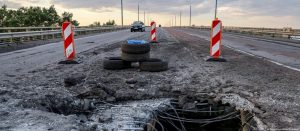
According to Roman Goncharenko of DW in https://www.dw.com/en/kherson-ukraine-battles-to-reclaim-the-gateway-to-crimea/a-63062473, published 09/09/2022September 9, 2022, “Russia occupied the southern Ukrainian region of Kherson early on in its invasion. Now, Kyiv’s counteroffensive is trying to recapture the strategically important area.”
It started with holes in the pavement. Cellphone videos from July 19 show the impact of rockets that struck the Antonovsky Bridge, one of the largest and most important in Kherson.
With the southern Ukrainian city currently controlled by Russian troops, the Ukrainian army has been deploying the HIMARS precision missile system in the area. Kyiv has been using these weapons, which arrived recently from the US, to fire upon the 1,366-meter (4,482 feet) bridge, disrupting logistics for the Russian troops located on the right bank of the Dnieper, Ukraine’s largest river. These attacks, and similar ones that followed, paved the way for Ukraine’s counteroffensive, which began in August.
Other bridges, along with Russian weapons depots in the region, have been consistently targeted since then. In early September, Ukrainian President Volodymyr Zelenskyy announced that various towns had been recaptured. The fight for Kherson could become one of the most crucial events of the war in the coming months.
Struggle for fresh water in Crimea
Russia captured the entire Kherson region during the early days of the invasion. Military resistance was minimal, and the region’s capital city, Kherson, home to some 280,000 people, was occupied in early March.
Amateur videos show how Ukrainian civilians, most of whom speak Russian, protested the Russian troops. No other region of Ukraine was occupied so quickly. It remains unclear how this was possible, and the question remains a painful one for the government in Kyiv.
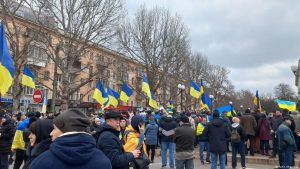
Ukrainians protested against Russia’s takeover of Kherson in the early days of the invasion (following March capture by Russia)
The region of Kherson extends some 28,500 square kilometers (11,000 square miles), making it nearly as large as Belgium. The landscape is characterized by steppes — wide open spaces as far as the eye can see. Viewed strategically, it may well be the most important region of southern Ukraine due to its access to two seas: the Sea of Azov in the east and the Black Sea in the west.
More importantly: the region of Kherson offers the only land connection to Crimea. It is the gateway to the peninsula that Russia annexed in 2014 — and this gateway has remained largely open during the Russian invasion. No bridges were blown up, which could have halted troop deployments. Large Russian units in Crimea were able to advance hundreds of kilometers to the north.
Russia’s principal goal during that operation was likely gaining control of the North Crimean Canal, which starts near the city of Nova Kakhovka, some 80 kilometers east of Kherson, and ends in the Crimean city of Kerch. The peninsula is chronically short of water; ever since Soviet times, it has received fresh water from the Dnieper via this canal. Following the annexation, Ukraine stopped this water flow, which led to problems for the peninsula’s water-intensive agriculture industry. In response, Russia blew up a dam that had been built in 2014, once again restoring the water supply.
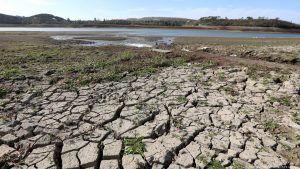
Crimea receives fresh water via the North Crimean Canal. Supply cutoffs following Russia’s annexation resulted in shortfallsImage: Alexei Pavlishak/TASS/picture alliance
By occupying Kherson and other cities near the mouth of the Dnieper, the Russian army was also simultaneously able to block Ukraine’s all-important water access to the Black Sea.
Kherson known for shipbuilding and watermelons
Kherson is best known for its shipbuilding industry. The city at the mouth of the Dnieper was founded at the end of the 18th century, when the region was part of the Russian Empire. It was named after the ancient Greek settlement Chersonesus in Crimea.
Kherson is home to the oldest seaport on Ukraine’s Black Sea coast, and it is where the first warships for the Russian Black Sea fleet were built. Since Soviet times, Kherson has specialized in civilian freight ships, including tankers. In February 2022, just a few days before the Russian invasion, the shipyard announced it had signed a contract for the construction of four cargo ships for the Netherlands.
When Ukrainians think of Kherson, however, the first thing that comes to mind is not ships, but watermelons and tomatoes. Kherson watermelons are particularly legendary. Every year, starting in August, Ukrainian stores are full of the sweet fruit — though not this year. Across social networks, photos of Ukrainian soldiers holding a watermelon in their hands have become a symbol of territorial recapture.
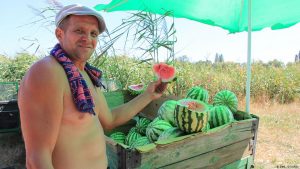
Watermelons from Kherson are well-known across UkraineImage: DW/L. Grischko
The Kherson region is famous for its cultivation of fruits and vegetables. It boasts some 2 million hectares of agricultural land — the most in all of Ukraine, and nearly twice as much as in the Netherlands. It should come as no surprise that the first Ukrainian ketchup manufacturer, Chumak, was founded there in 1993, in the city of Kakhovka. The company, which was started by two Swedes, is considered one of independent Ukraine’s success stories. Its website proudly notes that it owns Europe’s largest cucumber field.
Kakhovka was occupied by Russian troops during the first days of the war. Chumak, currently number two on the Ukrainian market, halted production and moved its headquarters to Kyiv.
No quick path to victory
Due to its location near Crimea, Russia is likely to put up a strong defense of the occupied territory of Kherson and the North Crimean Canal in particular. Observers in Ukraine and the West expect a long fight, and reckon Ukraine will not launch a frontal offensive due to insufficient forces.
Instead, it is thought that Kyiv will attempt to push out Russian troops through local attacks. In addition to freeing various villages, Ukraine’s counteroffensive also scored an additional victory: Earlier this week, a “referendum” for unification with Russia, modeled after a similar vote in Crimea in 2014, was postponed until further notice.
DW: This article has been translated from German.
fLASHBACk: Ukraine war: Why Kherson and Mariupol are key to Russian success
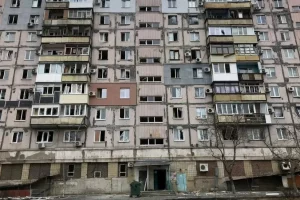
The Ukrainian city of Mariupol, when it came under heavy shelling by Russia before takeover.
Before the capture of Kherson in March, BBC had reported telling why Kherson and Mariupol are key to Russian success. In the report by BBC’s Ben Tobias on Friday March 4, 2022, it was clearly state that while Russian troops in the north and east of Ukraine had struggled to seize important targets, including the capital Kyiv, their advance into southern Ukraine appears to be more successful.
“Russia sees the south as vital to the success of its invasion, and has been laying siege to several southern cities and captured the Zaporizhzhia nuclear power plant, which is Europe’s largest. The operation in the south was launched from Crimea, which was annexed by Russia from Ukraine in 2014 and is home to a sizeable Russian military presence.
On Wednesday October 2, Pentagon spokesperson John Kirby said that Russia has a “sophisticated and healthy architecture” there.
A look at the map below shows how crucial the peninsula is as a base to the assault on southern Ukraine.
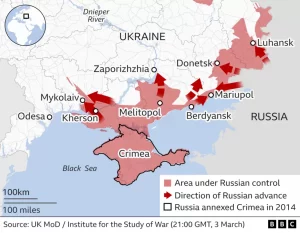
Russian troops are moving into Ukraine from Crimea, spreading east towards Mariupol and west towards Odesa, threatening to cut off Ukraine’s maritime access which would inflict huge economic damage on the country.
“Strategically, there are major ports in that region that really allow Putin’s forces to strangle any ability for Ukraine to be supplied via sea,” Karl Qualls, professor of history and Russia specialist at Dickinson College, told the BBC.
To the east of Crimea, Russian forces are pushing to Mariupol, a city of 450,000 people, which is encircled and coming under heavy shelling. Water and power supplies have been cut off, and residents have told the BBC that they are terrified.
If Mariupol falls, it would give Russia control of one of Ukraine’s biggest ports and create a land corridor between Crimea and the Russian-backed regions of Luhansk and Donetsk.
Connecting Crimea with mainland Russia via the rebel-held areas would make it much easier for Russia to move goods and people to and from Crimea. Russia has wanted this since 2014, when the conflict in the east began.
Currently the peninsula is connected to the Russian mainland only via a single bridge, built at great expense after the Russian annexation.
Nuclear power plant seized
North-west of Mariupol, Russia has seized the Zaporizhzhia power plant. In normal times the plant produces around 20% of Ukraine’s electricity, so by taking it Russia controls a significant portion of Ukraine’s possible power supply.
The Russian military has also occupied the city of Kherson which is located where the Dnieper river meets the Black Sea, a important location for troops to move further into Ukraine.
“We’re seeing them exploit the capture of Kherson,” Dr Jack Watling from the Royal United Services Institute told BBC Radio 4’s Today programme. “They’re now on the western side of the Dnieper and able to push both further up the river and towards Odesa.”
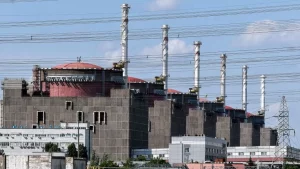
Russia says its forces have surrounded Ukraine’s largest nuclear power plant
If Russia is able to move further west, to Odesa and beyond, it would not only cut off Ukraine’s access to the sea but also surround the country on three sides.
“If they take Odesa, they have a key city to create a strategic arc around Ukraine. With Belarus in the north and Donbas to the east, they’ve all but encircled the country,” Catherine Wanner, professor of history and Russia and Ukraine expert at Penn State University, told the BBC in its report of March 4, 2022. There was more.
